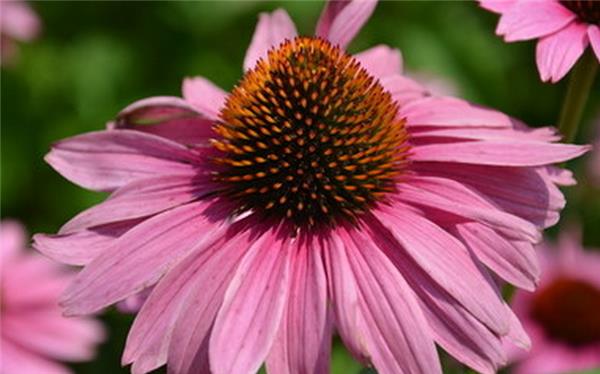Echinacea introduction and cultivation techniques How to raise beautiful Echinacea
Echinacea is a beautiful ornamental plant, echinacea can be divided into many different genera and species, next, let's have a look.

I. introduction of echinacea
The genus Echinacea has purple flowers, perennials, and is often cultivated as border plants (especially narrow-leaf echinacea (E. angustifolia) and purple echinacea (E. purpurea). It has black roots, strong smell, hairy stems, basal leaves and long stalks. North New World echinacea (R. columnaris) and R. pinnata are planted in wildflower gardens. About 25 species of the genus Rudbeckia, annual, biennial or perennial; simple or lobed leaves, yellow marginal flowers, brown or black disk flowers. Black-eyed Susan (R. hirta), thimble flower (R. bicolor) and echinacea (R. laciniata) are planted as border flowers. Jinguangju (R. laciniata var. Echinacea of Compositae, perennial herb, 60-150cm tall, hirsute throughout, stem erect; basal leaves ovate or triangular, cauline leaves ovate-lanceolate, petiole slightly clasping at base; capitate inflorescences solitary at the top of branches, or several aggregated, flowers up to 10cm, ligulate flowers purplish red, tubular flowers orange-yellow. The florescence is from June to July.

2. Potted technology of echinacea.
Potted soil needs loose and fertile mixed soil or cultivated soil. When planting, depending on the size of each basin, you can plant 3-5 seedlings. In the early stage of growth, it is necessary to remove the heart once to promote branching. It is better to renew the cultivated plants once a year. Watering should not be excessive, and watering should be controlled during the rainy season and when the air humidity is high. During the growth period, we should apply dilute liquid fertilizer to promote growth. Fertilize once a week when the bud is formed. Sprinkle water after each fertilization to prevent fertilizer from sticking to the plant. In order to avoid the rain, the cultivation is generally carried out in the greenhouse and should be placed in a well-ventilated and sunny place. The lowest temperature should not be lower than 10 ℃, and proper shade is needed in hot summer.

3. Sowing and propagation of echinacea
Sowing can be carried out in late April in spring or early September in autumn. After the seedling bed in the open field is leveled, the seeds are watered thoroughly. After all the water seeps into the ground, the seeds are removed, the area of each seed is kept 4cm2, the temperature is controlled at about 22 ℃, and the seeds can germinate in 2 weeks. The seedlings jumped to 2 true leaves and the seedlings were transplanted. It was planted when the seedling height was about lOcm. Determine the row spacing of 40cm × 40cm.
IV. Ramet propagation of echinacea
For perennial mother plants, it can be propagated in spring and autumn. Each plant needs 4-5 terminal buds to be cut off from the rhizome.

5. Cultivation and management of echinacea
No matter the ramet or sown plants, the sunny environment should be chosen when planting, and the soil should be deeply turned over with rotten stable fertilizer or add a certain amount of bone powder, sesame residue and so on. The row spacing of the planted plant was determined according to the need, and watered thoroughly. Fertilizer and water should be applied during the growing period. If potassium permanganate liquid fertilizer is sprayed twice near the flowering stage, the flower color will be bright and lasting, and the plant shape will be plump and symmetrical. For overwintering plants in the open field, residual flowers, branches and dead leaves should be removed after flowering, frozen water should be fully watered or the underground part should be covered with compost or choked soil. In order to make echinacea blossom more, we can adopt two methods: sowing by stages and pruning in time after flowering.
⑴ sowing by stages: if sowing in the autumn of the first year, it can blossom at the end of April or early May, and the flowering period can be more than two months; sowing in early spring in the greenhouse, flowering in July-August; sowing in May, flowering in September; sowing in June, flowering in October.
⑵ pruning residual flowers to adjust florescence. If the flowers are pruned after fade in June, and good fertilizer and water conditions are given at the same time, they can bloom again from September to October.
The above is the introduction of echinacea. I hope I can help you.
- Prev

Introduction and breeding skills of Binju, a close friend of feminists
Introduction and breeding skills of Binju, a close friend of feminists
- Next

Knowledge of flower preservation let flowers accompany you to watch sunrise and sunset
Knowledge of flower preservation let flowers accompany you to watch sunrise and sunset
Related
- Wuhan Hospital Iron Tree Blooming Result Was Instantly Frightened by the Gardener Master
- Which variety of camellia is the most fragrant and best? Which one do you like best?
- What is the small blue coat, the breeding methods and matters needing attention of the succulent plant
- Dormancy time and maintenance management of succulent plants during dormancy
- Minas succulent how to raise, Minas succulent plant pictures
- What are the varieties of winter succulent plants
- How to raise succulent plants in twelve rolls? let's take a look at some experience of breeding twelve rolls.
- Attention should be paid to water control for succulent plants during dormant period (winter and summer)
- Watering experience of twelve rolls of succulent plants
- Techniques for fertilizing succulent plants. An article will let you know how to fertilize succulent plants.

